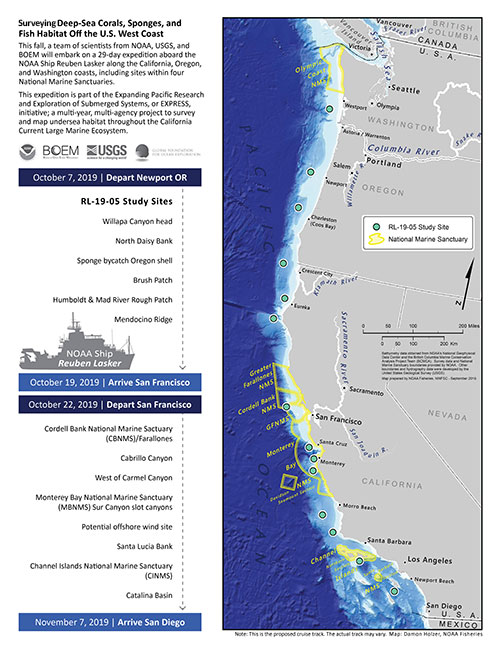
This fall, a team of researchers will explore the deep sea, one of the largest, but least known environments on Earth. Recent advances in deep-ocean exploration have revealed spectacular coral gardens in the dark ocean depths, far from the sunny, shallow reefs most of us associate with corals. Similar explorations have revealed new and familiar species thriving where we once expected little activity.
During this expedition, researchers will be surveying deep-sea coral and sponge environments off the U.S. West Coast. This cruise is part of a four-year West Coast Deep Sea Coral Initiative, supported by the Deep Sea Coral Research and Technology Program, to better understand the basic biology, abundance, and diversity of deep-sea coral throughout the California Current Large Marine Ecosystem as well as their ecological role with invertebrates and fish.

The proposed cruise track for the Surveying Deep-sea Corals, Sponges, and Fish Habitat Off the U.S. West Coast expedition. Image courtesy of NOAA. Download larger version (jpg, 2.3 MB).
From October 7 to November 7, 2019, scientists and engineers from NOAA, the Global Foundation for Ocean Exploration, the U.S. Geological Survey (USGS), and Bureau of Ocean Energy Management (BOEM) will conduct a 29-day expedition aboard NOAA Ship Reuben Lasker along the California, Oregon, and Washington coasts, including sites within four National Marine Sanctuaries.
The expedition will be divided into two legs. The first leg will depart Newport, Oregon. Over the following month, the ship will travel down the coast, eventually docking in San Francisco in mid-October. While in San Francisco, the crew will host a public engagement with the Exploratorium Museum. The second leg will continue down the coast until they conclude the expedition in San Diego in early November.
The researchers will collect samples to help identify West Coast corals and sponges and revisit previously surveyed sites to document changes that have occurred over time. One goal for the researchers will be to collect essential fish habitat baseline information at 12 sites along the West Coast. The Pacific Fishery Management Council proposed modifications to these habitats to better support commercially important groundfish.
Another important goal of characterizing this undersea habitat is to inform possible locations offshore northern and central California for wind energy development. Characterization will identify sensitive habitats to avoid when establishing future offshore wind energy sites.
Researchers will use a wide array of advanced technology to explore and characterize deep-sea habitats, including:
Expedition operations will run around the clock, with alternating ROV and AUV dives. The on-ship researchers will receive scientific support from a remote, distributed team of experts located back on land and connected to the ship by a high-speed communications link.
The same telepresence technology that allows us to connect with experts throughout the world will also enable the public to follow our discoveries and interact with our scientists. Using reliable technology provided by the Global Foundation for Ocean Exploration, you can follow the live stream from the ROV and ask our scientists questions. While we can never anticipate weather and technical difficulties, typically our ROV operations will take place during the evening and overnight hours. Highlights from the previous evening’s dive will be played the following day.
The Expanding Pacific Research and Exploration of Submerged Systems, or EXPRESS, initiative is a multi-year, multi-agency project to survey and map undersea habitat throughout the California Current Large Marine Ecosystem. This fall’s EXPRESS expedition represents an unprecedented level of government cooperation. Eight different NOAA offices along with USGS and BOEM contributed financial or scientific expertise to this expedition.